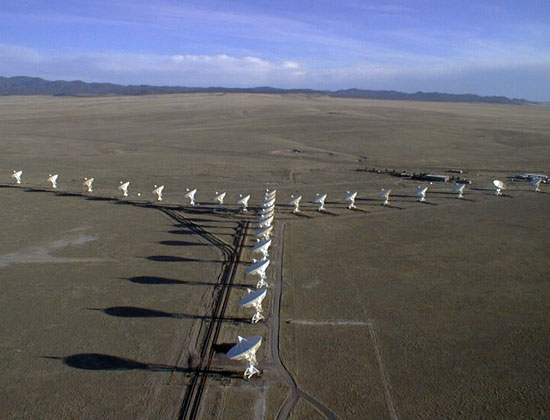Earth Based Telescopes – Radio Telescopes
The stars, galaxies and other astronomical objects emit radio waves. These radio waves can be detected on Earth by radio telescopes.
Radio telescopes are devices that are designed to receive radio waves from space. Radio telescopes consist of three main components.
- A radio reflector dish
- A radio antenna (receiver)
- A recorder

Radio Reflector Dish
The most common type of radio telescope used is a radio reflector. These consist of a parabolic dish or reflector which focuses the incoming radio waves onto a small central antenna, in the same way a curved mirror in an optical telescope reflects light waves onto a lens. Radio waves have a much longer wavelength than light waves (typically 100,000 times longer) and are therefore less susceptible to interferences caused by imperfections on the reflecting surface and therefore not constructed to the extent of smoothness required for glass mirrors. In fact for large wavelength radio waves the dishes can be constructed of a wire mesh to save on cost and weight. The intensity or strength of the radio waves reaching Earth from space is small. Therefore radio telescopes require large dishes in order to make useful and reliable measurements.
Radio Antenna (Receiver) and Amplifier
Radio waves induce a weak electrical current in a conductor. The radio waves collected on the dish are reflected and focussed on a central receiver where it is amplified to produce a signal strong enough to measure and record. The amplifiers used are designed to be extremely sensitive and are cooled to very low temperatures to minimise any interference that can be produced by the vibration of atoms in the metal.
Recorder
This is usually a powerful computer which records the signal and then runs sophisticated software to process the signal and analyse the data.
Advantages of radio telescopes
- Radio waves are not blocked by clouds and are unaffected by the Earth’s atmosphere, thus radio telescopes can receive signals during cloud cover. The exception being strong winds which affect the large dish and thunderstorms due to interference.
- Radio telescopes can be used in the daytime as well as at night.
- Radio waves are unaffected by the dust particles in space. Light waves are scattered by these dust particles and so never make it to Earth for detection. Radio waves with their much longer wavelengths are unhindered by these tiny dust particles and travel the vast distances across space to Earth giving radio astronomers un-obscured views.
- Radio telescopes can detect cool clouds of Hydrogen gas in space. These large clouds of gases are important because they are the birthplace of stars. Large clouds of Hydrogen gas do not produce visible light and so are invisible to optical telescopes. But they do emit radio waves at a specific wavelength allowing detection by radio telescopes.
- Certain hot objects become more luminous at radio wavelengths than at the visible light wavelengths. For example the hot gases orbiting black holes, such objects can be detected using radio telescopes.
Limitations of radio telescopes
The radio waves received on Earth are very weak and of low intensity. The intensity of an electromagnetic wave is the energy it delivers per second. Radio waves have low frequencies and long wavelengths resulting in low energy photons. Thus, in order to get a detectable signal radio telescopes require large collecting areas.
Due to the radio signals from space being so weak they are easily drowned out by interference from Earth based radio signal sources such as transmitters for Earth based satellites. This is why radio telescopes are located in remote regions away from civilization.
Radio telescopes have a low resolving power. This means they are poor at distinguishing small details in the objects they are viewing. The resolution of a telescope depends on the wavelength of the radiation source and the diameter of the reflector dish in the case of radio telescopes and mirror/lens for optical devices. As the wavelength of radio waves are much longer than that of visible light (typically 100,000 times longer) it means that the diameter of dish also need to be very large to get the same resolving power. So, for a radio telescope with an equal dish diameter as the lens in an optical telescope, the radio telescope will have approximately 100,000 times less resolving power.
Very Large Array (VLA)
The low intensity or strength of radio waves reaching Earth limits the signal strength and resolving power of radio telescopes.
Increasing the collecting area of the radio telescope can overcome this limitation. By using two or more radio telescopes together and simultaneously combining the signals they receive from the same source allows astronomers to increase the resolution power. The process of using two or more radio telescopes to collect the radio signals is called “arraying” and the technique of combining their signals is called “interferometry”. By properly combining the signals from two or more telescopes means each telescope can act as a small part in a very large telescope.
An example of an array of radio telescopes is the Very Large Array (VLA) in New Mexico. This consists of 27 radio telescopes positioned in a Y-shaped configuration. Radio signals collected by this array are combined to create high resolution radiographs (radio maps) of objects in space.

